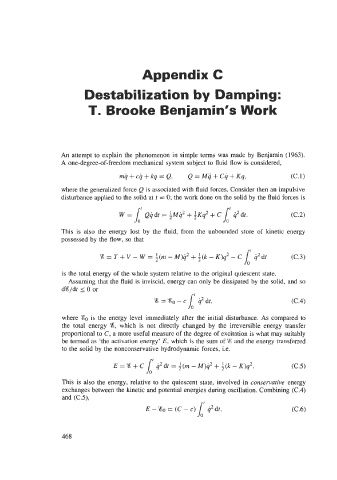Page 498 - Fluid-Structure Interactions Slender Structure and Axial Flow (Volume 1)
P. 498
Appendix C
Destabilization by Damping:
T. Brooke Benjamin’s Work
An attempt to explain the phenomenon in simple terms was made by Benjamin (1963).
A one-degree-of-freedom mechanical system subject to fluid flow is considered,
mq+cq+kq=Q, Q=Mij+Cq+Kq, (C. 1)
where the generalized force Q is associated with fluid forces. Consider then an impulsive
disturbance applied to the solid at t = 0; the work done on the solid by the fluid forces is
.=I’ Qq dt = iMq2 + iKq’ + C I‘ q2 dt. (C.2)
This is also the energy lost by the fluid, from the unbounded store of kinetic energy
possessed by the flow, so that
% = T+ V - W = i(m-M)q2 + i(k-K)q 2 - CL q’dt (C.3)
is the total energy of the whole system relative to the original quiescent state.
Assuming that the fluid is inviscid, energy can only be dissipated by the solid, and so
d%/dt 5 0 or
where ‘eo is the energy level immediately after the initial disturbance. As compared to
the total energy 73, which is not directly changed by the irreversible energy transfer
proportional to C, a more useful measure of the degree of excitation is what may suitably
be termed as ‘the activation energy’ E, which is the sum of % and the energy transferred
to the solid by the nonconservative hydrodynamic forces, i.e.
It (C.3
E=%+C
q2dt=i(m-M)q2+i(k-K)g. 2
This is also the energy, relative to the quiescent state, involved in conservative energy
exchanges between the kinetic and potential energies during oscillation. Combining (C.4)
and (C.3,
E - = (C - c)L‘ q’dt, (C.6)
468

